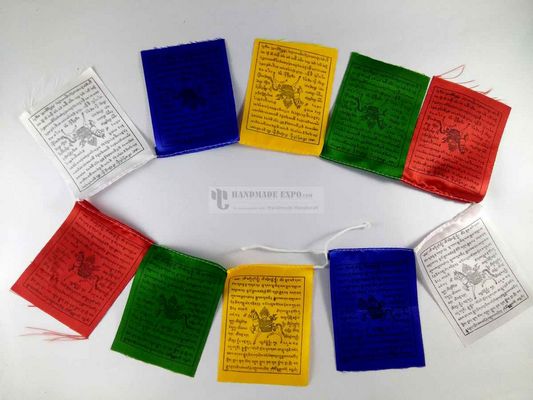Loading Content..

A prayer flag is a colorful rectangular cloth, often found strung along mountain ridges and peaks high in the Himalayas. They are used to bless the surrounding countryside and for other purposes. Prayer flags are believed to have originated with Bon. In Bon, shamanistic Bonpo used primary-colored plain flags in Tibet.Traditional prayer flags include woodblock-printed text and images.
Nepal Sutras, originally written on cloth banners, were transmitted to other regions of the world as prayer flags.used by the devas against their adversaries, the asuras. carrying the heavenly banner as a way of signifying his commitment to ahimsa. Indian practice of printing on cloth prayer flags to Tibet and Nepal.
Color And Order
Traditionally, prayer flags come in sets of five: one in each of five colors. The five colors are arranged from left to right in a specific order: blue, white, red, green, and yellow. The five colors represent the five elements. Five Pure Lights. Different elements are associated with different colors for specific traditions, purposes and sadhana. Blue symbolizes the sky and space, white symbolizes the air and wind, red symbolizes fire, green symbolizes water, and yellow symbolizes earth. According to Traditional Tibetan medicine, health and harmony are produced through the balance of the five elements.
Symbols and prayers
The center of a prayer flag traditionally features a Lung ta (powerful or strong horse) bearing three flaming jewels (specifically ratna) on its back. The Ta is a symbol of speed and the transformation of bad fortune to good fortune. The three flaming jewels symbolize the Buddha, the Dharma (Buddhist teachings), and the Sangha (Buddhist community): the three cornerstones of Tibetan philosophical tradition.
Surrounding the Lung ta are various versions of approximately 400 traditional mantras, each dedicated to a particular deity. These writings include mantras from three of the great Buddhist Bodhisattvas: Padmasambhava (Guru Rinpoche), AvalokiteÃ
âºvara (Chenrezig, the bodhisattva of compassion, and the patron of the Tibetan people), and Manjusri.
In addition to mantras, prayers for a long life of good fortune are often included for the person who mounts the flags.
Images or the names of four powerful animals, also known as the Four Dignities, adorn each corner of a flag: the dragon, the garuda, the tiger, and the snowlion.

Symbolism and tradition
Traditionally, prayer flags are used to promote peace, compassion, strength, and wisdom. The flags do not carry prayers to gods, which is a common misconception; rather, the Tibetans believe the prayers and mantras will be blown by the wind to spread the good will and compassion into all pervading space. Therefore, prayer flags are thought to bring benefit to all.
By hanging flags in high places the Lung ta will carry the blessings depicted on the flags to all beings. As wind passes over the surface of the flags, which are sensitive to the slightest movement of the wind, the air is purified and sanctified by the mantras.
The prayers of a flag become a permanent part of the universe as the images fade from exposure to the elements. Just as life moves on and is replaced by new life, Tibetans renew their hopes for the world by continually mounting new flags alongside the old. This act symbolizes a welcoming of life's changes and an acknowledgment that all beings are part of a greater ongoing cycle.
According to traditional belief, because the symbols and mantras on prayer flags are sacred, they should be treated with respect. They should not be placed on the ground or used on clothing. Old prayer flags should be burned.
 |  |  |  |
| Prayer flags at Swayambunath, Kathmandu. | A Darchog prayer flag in northern India. | Close-up of a Lung ta ("Wind Horse") prayer flag, Ladakh, India. | Prayer flags hung at streets of Thamel, Kathmandu |
Loading..
Please wait for the page to fully load for optimal functionality.
Loading Content..